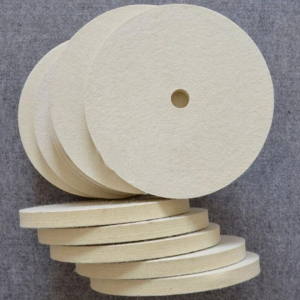The traditional wool felt wheel is undergoing a remarkable transformation as it integrates with smart technologies, leading to enhanced performance and new possibilities in the polishing industry. This convergence of old – school craftsmanship and modern technology is revolutionizing the way wool felt wheels are used.
One of the key areas of integration is the use of sensors. Smart wool felt wheels are now being equipped with sensors that can monitor various parameters during the polishing process. For example, sensors can measure the pressure applied to the surface being polished, ensuring that it remains within the optimal range. This is crucial as excessive pressure can cause damage to the surface, while too little pressure may result in an ineffective polish. By providing real – time feedback, these sensors help users achieve consistent and high – quality finishes.
Another aspect of smart integration is the use of connectivity. Some advanced wool felt wheels can be connected to mobile devices or computers via Bluetooth or Wi – Fi. This allows users to access detailed analytics about the polishing process, such as the amount of material removed, the speed of the wheel, and the total time spent on a particular task. Manufacturers can also use this data to improve their products, as they gain insights into how the wheels are performing in different applications.
In industrial settings, the integration of wool felt wheels with robotic systems is becoming increasingly common. Robots equipped with smart wool felt wheels can perform polishing tasks with a high degree of precision and repeatability. This is especially useful for large – scale production lines, where consistency is key. The robots can be programmed to follow specific polishing patterns and adjust the parameters of the wool felt wheel based on the surface characteristics of the product being polished.
The integration of smart technologies also has implications for maintenance and longevity. Sensors can detect signs of wear and tear on the wool felt wheel, alerting users when it needs to be replaced. This proactive approach not only ensures optimal performance but also reduces downtime in industrial operations. Additionally, the data collected from the smart wheels can be used to develop more durable and efficient designs in the future.
The combination of wool felt wheels and smart technologies is also opening up new opportunities in the field of education and training. Virtual reality (VR) and augmented reality (AR) can be used to simulate the polishing process with smart wool felt wheels, allowing trainees to practice and learn without the need for physical materials and equipment. This makes the training process more cost – effective and accessible.
As technology continues to advance, we can expect even more innovative integrations with wool felt wheels. The future may see the development of self – adjusting wool felt wheels that can automatically adapt to different surfaces and polishing requirements, further enhancing their performance and usability. The integration of smart technologies is set to take the humble wool felt wheel to new heights in the modern polishing industry.

Post time: Jun-10-2025
